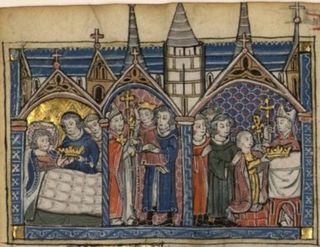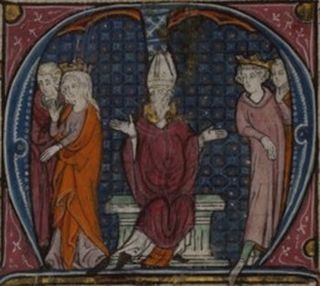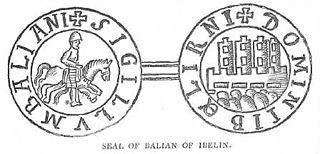Related Research Articles

Amalric, formerly known in historiography as Amalric I, was the king of Jerusalem from 1163 until his death. He was, in the opinion of his Muslim adversaries, the bravest and cleverest of the crusader kings.

William of Tyre was a medieval prelate and chronicler. As archbishop of Tyre, he is sometimes known as William II to distinguish him from his predecessor, William I, the Englishman, a former prior of the Church of the Holy Sepulchre, who was Archbishop of Tyre from 1127 to 1135. He grew up in Jerusalem at the height of the Kingdom of Jerusalem, which had been established in 1099 after the First Crusade, and he spent twenty years studying the liberal arts and canon law in the universities of Europe.

Raymond III was count of Tripoli from 1152 to 1187. He was a minor when Nizari Assassins murdered his father, Count Raymond II of Tripoli. His cousin King Baldwin III of Jerusalem, who was staying in Tripoli, made Raymond's mother, Hodierna of Jerusalem, regent. Raymond spent the following years at the royal court in Jerusalem. He reached the age of majority in 1155, after which he participated in a series of military campaigns against Nur ad-Din, the Zengid ruler of Damascus. In 1161 he hired pirates to pillage the Byzantine coastline and islands to take vengeance on Byzantine emperor Manuel I Komnenos, who had refused to marry his sister Melisende. He was captured in the Battle of Harim by Nur ad-Din's troops on 10 August 1164, and imprisoned in Aleppo for almost ten years. During his captivity, his cousin King Amalric of Jerusalem administered the county of Tripoli on his behalf.

Theoderic, commonly known as Thierry of Alsace, was the fifteenth count of Flanders from 1128 to 1168. With a record of four campaigns in the Levant and Africa, he had a rare and distinguished record of commitment to crusading.

The Kingdom of Jerusalem, one of the Crusader states that was created in 1099, was divided into a number of smaller seigneuries. According to the 13th-century jurist John of Ibelin, the four highest crown vassals in the kingdom proper were the count of Jaffa and Ascalon, the prince of Galilee, the lord of Sidon, and the lord of Oultrejordain.
Heraclius or Eraclius, was archbishop of Caesarea and Latin Patriarch of Jerusalem.

There were six major officers of the Kingdom of Jerusalem: the constable, the marshal, the seneschal, the chamberlain, the butler and the chancellor. At certain times there were also bailiffs, viscounts and castellans.

Agnes of Courtenay was a Frankish noblewoman who held considerable influence in the Kingdom of Jerusalem during the reign of her son, King Baldwin IV. Though she was never queen, she has been described as the most powerful woman in the kingdom's history after Queen Melisende.
Baldwin of Ibelin, also known as Baldwin II of Ramla, was an important noble of the Kingdom of Jerusalem in the 12th century and was lord of Ramla from 1169-1186. He was the second son of Barisan of Ibelin, and was the younger brother of Hugh of Ibelin and older brother of Balian of Ibelin. He first appears in the historical record as a witness to charters in 1148.

Balian of Ibelin, also known as Barisan the Younger, was a crusader noble of the Kingdom of Jerusalem in the 12th century. He was Lord of Ibelin from 1170 to 1193. As the leader of the defense of the city during the siege of Jerusalem in 1187, he surrendered Jerusalem to Saladin on 2 October 1187.
Miles of Plancy was a French-born nobleman who rose to high offices in the Kingdom of Jerusalem. He arrived in the kingdom during the reign of his kinsman King Amalric, who appointed him seneschal in 1168. Miles accompanied the king on two campaigns in Egypt. In early 1174 the king arranged for Miles to marry a great heiress, Stephanie of Milly, which made Miles lord of Oultrejordain, one of the largest fiefs in the kingdom. Amalric died on 11 July 1174 and was succeeded by his minor son, Baldwin IV. A regent was not immediately appointed to rule in the boy king's name, and so Miles duly assumed the government in his capacity as seneschal. He was of a too imperious temperament to cooperate with other noblemen, however, and soon caused resentment that led to his murder.

Frederick of la Roche was the sixth Latin archbishop of Tyre (1164–1174), chancellor of the kingdom of Jerusalem, and the chief diplomat of King Amalric. He was a Lorrainer, from the town of La Roche, of noble stock.
Gilbert of Assailly was the fifth master of the Knights Hospitaller, serving from 1162 or 1163 to 1170, when he was deposed. As Grand Master, he succeeded Auger de Balben. Nevertheless, most sources list him as the fifth, rather than fourth, master and this biography continues that tradition, with the exception being Delaville Le Roulx' work. He was succeeded by Gastone de Murols. Gilbert encouraged Amalric of Jerusalem in his unsuccessful invasion of Egypt, leaving the Order in debt and causing the reexamination of its military role.
Fulkof Angoulême was the Latin patriarch of Jerusalem from 1146 to his death in 1157.

Aimery or Aymery of Limoges, also Aimericus in Latin, Aimerikos in Greek and Hemri in Armenian, was a Roman Catholic ecclesiarch in Frankish Outremer and the fourth Latin Patriarch of Antioch from c. 1140 until his death. Throughout his lengthy episcopate he was the most powerful figure in the Principality of Antioch after the princes, and often entered into conflict with them. He was also one of the most notable intellectuals to rise in the Latin East.

Amalric of Nesle was a Catholic prelate who served as the Latin patriarch of Jerusalem from late 1157 or early 1158 until his death. Amalric focused chiefly on managing church property; he showed very little political initiative and, unlike many contemporary bishops in the crusader states, had no interest in military affairs.
The Roman Catholic Archdiocese of Tyre was an archbishopric in the Kingdom of Jerusalem.
Peter of Barcelona was a prelate of the Catholic Church in the Kingdom of Jerusalem. He was prior of the Holy Sepulchre from 1144 to 1151 and then archbishop of Tyre until his death.
William was the bishop of Acre in the Kingdom of Jerusalem from c. 1164 until his death on 29 June 1172. He was sent on several diplomatic missions by King Amalric. He was murdered by an apparently mentally ill retainer while returning from a mission to his native Italy.
John was the bishop of Banias in the Kingdom of Jerusalem from 1161 until his death in 1170.
References
![]() This article incorporates text from a publication now in the public domain : Laughton, John Knox (1896). "Ralph (d.1174)". In Lee, Sidney (ed.). Dictionary of National Biography . Vol. 47. London: Smith, Elder & Co.
This article incorporates text from a publication now in the public domain : Laughton, John Knox (1896). "Ralph (d.1174)". In Lee, Sidney (ed.). Dictionary of National Biography . Vol. 47. London: Smith, Elder & Co.